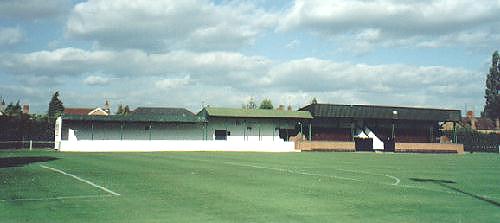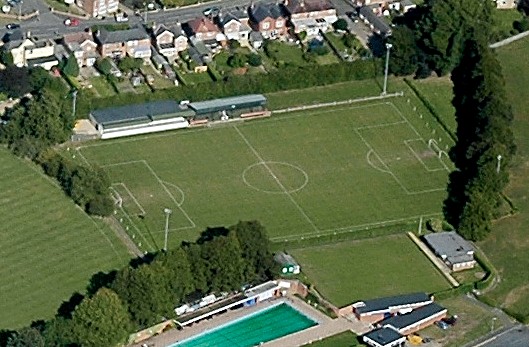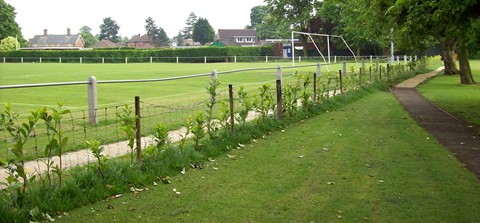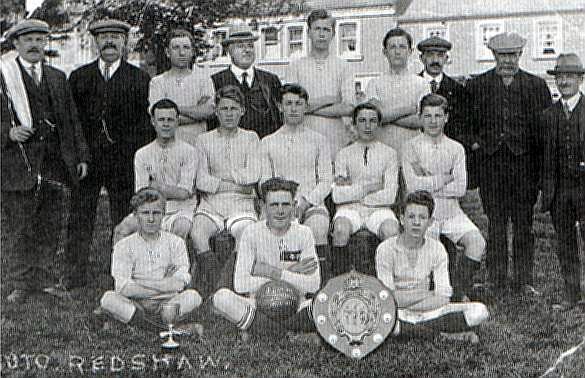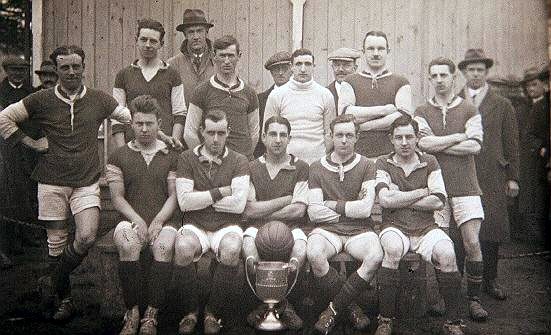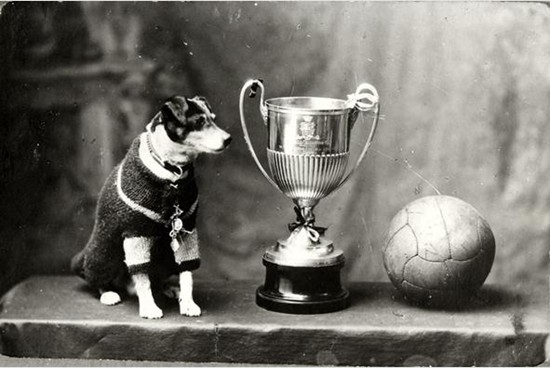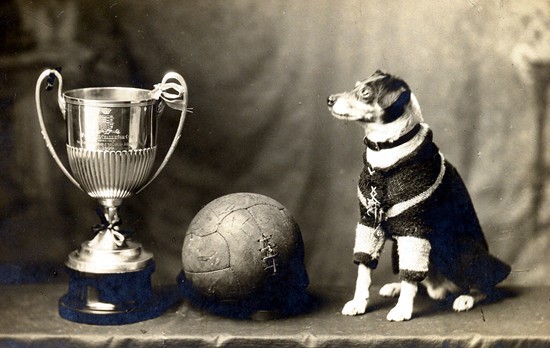Bourne Town Football Club
The most popular sport to be played at the Abbey Lawn is soccer and over many years, Bourne teams have generally gained a high reputation for their games. Bourne fielded a soccer team during the 19th century and I have records of matches being played as early as 1871 although it was known as the Bourne Temperance Club, a Temperance Society having been formed in the town in 1863. On Saturday 26th September 1871, Bourne played Morton away and the Stamford Mercury reported: "For about an hour and a half, the game was kept up with spirit, neither side appearing to gain any advantage, but the Morton club was fortunate enough to obtain the first and only goal." There is also evidence that games were played mid-week as well as Saturdays but the rules and style of play were quite different from today. On Wednesday 21st February 1872, the club met Sleaford on the ground we now know as the Abbey Lawn when the match was drawn 1-1. The following Saturday, the club played Morton on the same ground when Bourne won, although the score is not recorded. In the same year, the weather was so cold that the football season was extended and the return fixture was played at Morton on June 10th when the home side won by three goals to nil. The Bourne players listed, thirteen in each side, were: G H Elvidge (captain), Wyles, Cartledge, Darnes, Tittis, Mansfield, Mays, Pateman, Plowright, Stevenson, Shipley, Hinson and Ogsthorpe. For Morton: P E Stockdale (captain), Brown, Casterton, F Chantry, J Chantry, Darnes, Ellis, Martin, A Rodgers, R Rodgers, E Smith, A H Stockdale and Stow. The Bourne Temperance Club played Morton again on 29th October 1872, this time away, and won 1-0. The Bourne club played Holbeach on 27th December 1872 on the Abbey Lawn, by kind permission of the vicar, when the home side won by two goals. The Bourne players listed, twelve in each side, were: A Bott (captain), C Mawby, F Mawby, H Bott, W Sang, W Wyles, Andrews, Skinn, Thornton, Stockdale, F Smith, T H Carter. The Holbeach team were: T Caparn, B Caparn, F Harvey, C Harvey, S Clarke, A Clarke, R Harper, H G Maples, R Maples, Macdonald, Hawkins and J F Downing. During the 1872-73 season, they played Sleaford away and then at home and the return match, at the Abbey Lawn on Saturday 18th January 1873, resulted in a draw, both sides being hampered by high winds throughout the game. There was also a match with Spalding at the Abbey Lawn in April 1874 which the home team won but the team on this occasion it was known as the Bourne Star Football Club. Bourne played Grantham at the Abbey Lawn on 8th January 1875, when the visitors won, and again on 26th November that year when the game ended in a draw, or, as the report put it: "It was a spirited game that ended without a victory on either side, time being up before a goal had been obtained by either party." Games were also played regularly on the Abbey Lawn during 1876, versus Sleaford on Saturday 19th January when Bourne lost by one goal in "a game very energetically contested to the end", and versus Stamford on Saturday 5th February when Bourne won 4-1. A fixture list also exists from the 1877-78 season detailing away matches with Stamford, Sleaford, Boston, Grantham and Spalding, and it is likely that the team travelled to these games by train because by that time Bourne had become a thriving railway centre in South Lincolnshire. During that season, Bourne beat Spalding at home twice, 5-0 and 3-2, drew 0-0 at home with Sleaford and beat Stamford at home 4-0. At least three matches were played during 1879, against Sleaford away on Saturday 15th February when Bourne lost 3-0, on Saturday 8th March when they travelled to Stamford to play the Burghley Park team which they won 2-1 and a home match with Sleaford which they drew 2-2 on Saturday 25th October. The Bourne teams on those occasions were often referred to as the town club although the first records we have about a Bourne Town Football Club is 1882. A meeting was called at the Bull Hotel [now the Burghley Arms] on Thursday 19th October that year with Mr James Bell, a local solicitor, in the chair and after some discussion, it was decided to revive the club that existed in years past. Mr W E L Bell was elected captain and Mr H T Carter was appointed honorary secretary and treasurer. The subscription for playing members was fixed at 1s. 6d. and it was hoped that this low sum would induce more people to join. The subscription for playing members was increased to 2s. 6d. at the annual meeting held at the Bull Hotel on Thursday 18th September 1884 when arrangements were made to play Spilsby away on January 2nd the following year and letters were also sent off to arrange home and away fixtures with clubs at Boston, Stamford, Spalding, Peterborough and Long Sutton. The officers elected that year were A Bott (captain), J A Chadwick (sub-captain) and F T Carter (secretary and treasurer). There was still a healthy interest in the club and the future of competitive football in the town seemed assured. But this optimism proved to be unfounded because the club closed down through lack of support after a few seasons and it was to be another 13 years before it was re-formed on a permanent basis. Other attempts to start a club were made in the intervening years and a team called the Bourne Rovers booked the Abbey Lawn for the entire season of 1887-88. Then on Thursday 21st August 1890, the Bourne Wanderers' Football Club was formed at a public meeting held at Barker's Refreshment Rooms when the local MP, Mr Henry Cust, the member for the Stamford division, was invited to become president. Other officers and a committee were elected and it was decided that practice sessions would be held on Tuesday and Friday evenings at the recreation ground, then situated at Hereward's Field [now the Wellhead Field], and matches would be played at the Abbey Lawn. An annual meeting was held at the Angel Hotel the following year, on Tuesday 22nd September, when Dr James Watson Burdwood, the Medical Officer of Health, was elected president, but this club did not last after the end of that season. In September 1894, another meeting to form a football club was held at the Crown Hotel and although officers and a committee were again elected, it did not survive after that season. The following year, in 1895, a team called the Bourne Amateurs was formed but this too was short-lived and lasted only one season. The club that we know today was actually founded on Tuesday 24th August 1897 when a general meeting was held at the Nag's Head Hotel under the chairmanship of Mr Robert Gardner who expressed his pleasure at seeing such a large attendance and added: "I have no doubt that if our efforts are directed on the right lines, we will be able to organise a football club that will give a good account of itself. Years ago, Bourne possessed an excellent team and it is our desire to see the town again take a high place in football annals. We have the material. It is now only a question of unity and good organisation." Mr John Crane, a brewery agent, of West Street, proposed that the club be formed and a committee appointed and this was unanimously adopted. The following officers were then appointed: President: Mr Robert Gardner; vice-presidents: the Rev Hugh Mansfield, Thomas Mays, Alderman William Wherry, Alexander Farr, Albert Dainty, Dr James Watson Burdwood, Robert Mason Mills, Arthur Saul . . . and other gentlemen with whom the secretary was requested to communicate; honorary secretary John Crane; treasurer Walter Green; captain Mr Thomas and vice-captain Mr Barker; committee Messrs G H Mays, J B Shilcock, R Andrews, F J Clarke, J T Pearce, E Chamberlain, A Bott, F G Shilcock, J A Chadwick, H Bloodworth and W Harrison. The annual subscription for membership was fixed at 2s. 6d. and the club colours were selected as crimson and black with the Abbey Lawn as the club's home ground. The club today however claims 1883 as the official year of its inception although I have found no evidence for this and 1897 would appear to be the correct date. Since the inaugural meeting that year, the club has been nicknamed The Wakes and their colours changed to claret and sky blue while improvements to the ground over the years have given it a capacity of 5,000. The team is also backed by an active supporters' club and has drawn Saturday afternoon crowds to the ground for many seasons past with a record attendance of over 3,000 for the FA Trophy match with Chelmsford in 1970. The team has also achieved many notable
successes including the championship of the United Counties league on four
occasions, in 1968-69, 1969-70, 1971-72 and 1990-91. The club has also
spawned several players who have progressed to the Football League
including Peter Grummit (Nottingham Forest and Brighton & Hove
Albion), Shaun Cunnington (Wrexham,
Grimsby and Sunderland) and David Palmer (Wrexham). Mr Pick died in January 2004 and left a generous settlement to the club in his will, including an outright bequest of £100,000 for the purposes of improving its facilities at the Abbey Lawn and a further sum of £100,000 to be invested by his executors in safe securities with the net annual income being paid to help defray running costs. Much of the bequest was spent on installing the Len Pick Suite at the club's headquarters in his memory but persistent vandalism at the ground prompted the formation of the Abbey Lawn Action Group, comprising members from the club, other sporting organisations and interested parties, to improve security precautions and in 2007, Bourne United Charities agreed to fund a nine-foot high fence at vulnerable sections of the Abbey Lawn at a cost of £42,000.
In the spring of 2008, the club decided to
protect its ground at the Abbey Lawn by planting an evergreen laurel hedge
around the perimeter which was expected to grow to six feet within three
years.
REVISED FEBRUARY 2015 See also The successful season of 1904-05 The tale of a teapot
Go to: Main Index Villages Index
|
|||||||||||||||||||||||||||||
